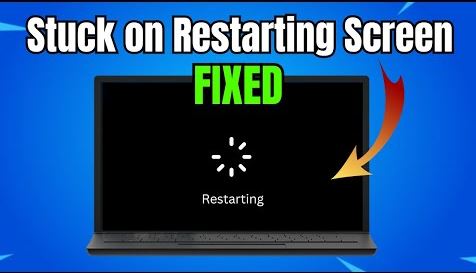Frozen on Restart When encountering a “Windows Stuck on Restarting Screen” issue, several factors could be at play, such as bad USB devices, unresponsive apps, or system and BIOS update issues. One can attempt solutions like waiting, unplugging external devices, performing a force restart, or booting into Safe Mode to fix this. Running system tools like SFC, DISM, or CHKDSK might help with deeper issues. If the problem persists, one might need to look into driver updates, close non-responsive applications, check for malware, uninstall problematic updates, or even try System Restore. If all else fails, Windows Startup Repair or accessing Advanced Startup Options could be the last resort.
Troubleshooting Windows PC Stuck on Restarting Screen
Have you recently updated your Windows 11/10 PC and found yourself staring at a screen that just doesn’t seem to get past “Restarting”? This can be a frustrating experience, especially when you’re in a hurry to use your computer. This issue is commonly experienced after upgrading to a recent Build Update or following the occurrence of certain errors, such as the Blue Screen (BSOD) or Black Screen of Death.
In this article, we’ll discuss the potential causes for your computer getting stuck on the restarting screen and provide you with a list of possible solutions to get your system back up and running.

Why Your Windows PC May Not Respond to Restart – Frozen on Restart
Several factors could be at play when your screen freezes or becomes unresponsive during a restart:
- Bad or corrupt USB devices connected to the PC
- System apps becoming unresponsive during the restart process
- Internal file, folder, or BIOS issues
- Pending Windows or BIOS update
- Accumulated cookies or cache
Other issues such as enabled Fast Startup, unresponsive device drivers, and disabled indexing services could also contribute to Windows getting stuck on the restarting screen.
Fixing Windows Stuck on Restarting Screen
If you’re facing this issue on your Windows 11/10 PC, here are the steps you can take to try and resolve it:
1. Wait for Some Time
Sometimes, the easiest fix is to wait. Your Windows may just be taking extra time to apply updates or changes during the restart. Give it a few more minutes and see if it progresses on its own.
2. Unplug External USB Devices
Remove any external USB devices connected to your PC and then attempt a force restart. These devices can sometimes cause conflicts, especially during the startup process.
3. Force Restart your PC
If waiting and unplugging USB devices didn’t work, you’ll need to perform a force restart by holding down the power button until your computer shuts off. Wait for about 10 seconds before turning it back on to see if the issue persists.
If you still have access to the Command Prompt, you can also force a restart with the shutdown -r command.
4. Boot into Safe Mode
Booting into Safe Mode can help bypass potential software issues hindering your normal boot-up process. To do this, restart your PC and press the F8 key before the Windows logo appears. From the Advanced Boot Options menu, select Safe Mode to see if this resolves the problem.
5. Check for Driver Updates
Outdated or corrupt drivers can cause a multitude of issues. Navigate to Settings > Update & Security > Windows Update > View optional updates to see if there are any driver updates available. If there are, install them and reset your PC. Windows update catalog
6. Close Unresponsive Apps
Open the Task Manager (Ctrl + Shift + Esc) and close any apps that aren’t responding. Sometimes, an unresponsive program can prevent Windows from restarting properly.
7. Use SFC, DISM, and CHKDSK Tools
System File Checker (SFC), Deployment Imaging Service and Management Tool (DISM), and Check Disk (CHKDSK) are Windows utilities that can fix a variety of system issues.
To use these tools, you may need to boot into the Windows Recovery Environment and launch the Command Prompt with admin privileges. Run the following commands one at a time:
sfc /scannow Dism /Online /Cleanup-Image /CheckHealth chkdsk C: /f /r /x
8. Check for Malware
Malware can cause your system to hang on the restart screen. Boot into Safe Mode without networking and run a full antivirus scan to check for infections.
9. Uninstall Recent Updates via Advanced Options
If you began experiencing issues after a recent Windows update, consider uninstalling the update through Advanced startup options by navigating to Troubleshoot > Advanced Options > Uninstall Updates.
10. Use System Restore via Advanced Recovery
If you have created system restore points, you can back your Windows to a previous state where everything worked correctly. Access System Restore from Advanced startup options and follow the instructions to perform a restore.
11. Try Startup Repair
Howfixes Startup Repair is a built-in Windows tool that tries to fix startup issues. Access it through the Advanced startup options by choosing Troubleshoot > Advanced Options > Startup Repair.
Remember, advanced startup options can be accessed by holding the Shift key while selecting ‘Restart’ from the power menu in Windows.
Force restarting a Windows PC can be accomplished in a few different ways, including holding the power button, using Task Manager, Windows PowerShell, or Command Prompt.
If none of these solutions work and your computer is still stuck on the restarting screen, you may need professional help or consider resetting Windows as a last resort. Your data is precious, so always back up your files regularly to avoid data loss in such scenarios.